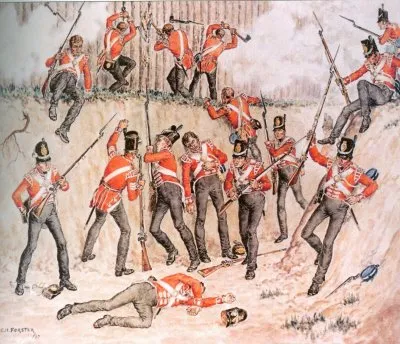Shadrack Byfield (sometimes Shadrach) was a British soldierwho served in the Light Infantry company of the 41st Regiment during the War of 1812. He the author of a memoir of his wartime experiences, A Narrative of a Light Company Soldier's Service, published in 1840. This work is notable as one of the only accounts of the war written by a common British soldier.
Born in Bradford on Avon to a family of weavers in 1789, Byfield enlisted in the Wiltshire Militia in 1807, aged eighteen. Two years later, he volunteered into the 41st Regiment and was sent to join the regiment in North America, serving in Lower Canada and at Fort George in modern-day Niagara-on-the-Lake prior to the outbreak of war.
He saw much service during the War of 1812; the Siege of Detroit, the Battle of Frenchtown (where he was wounded in the shoulder), the Siege of Fort Meggs, and the Battle of Fort Stephenson. Byfield narrowly escaped capture after the British defeat at the Battle of the Thames and later rejoining elements of his regiment in the Niagara area. He participated in the Capture of Fort Niagara and was at the Battle of Lundy's Lane. At the Battle of Conjocta Creek, an unsuccessful British raid on 3 August 1814 his left arm was shattered by musket ball. Byfield's forearm was subsequently amputated and he was invalided back to England, where he was awarded a pension from the Royal Hospital Chelsea in 1815.
Byfield returned to Bradford on Avon and married but was prevented from working at his trade as a weaver because he required use of both hands to operate a loom. However, according to his memoirs, a design for an 'instrument' came to him one night in a dream; this contraption enabled him to work at a loom with just one arm, allowing him to provide for his family.
Byfield published a memoir of his wartime experiences in 1840. Although some sources speculate that he died in 1850 more recent research suggests that Byfield actually died on 17 January 1874 in Bradford, aged 84.
Shadrack Byfield's Narrative provides a common soldier's perspective of the War of 1812. Because of this his humble account has been republished numerous times in many editions. Byfield has often been portrayed as the archetypical 1812-era British soldier by modern historians. John Gellner, who edited Byfield's memoirs in 1963, asserted that his story "could have been told by any one of those humble, patient, iron-hard British regulars who more than made up in discipline, training and bravery for their lack of numbers." Byfield is also the protagonist in a 1985 children's novel, Redcoat, by Canadian author Gregory Sass, which presents a heavily fictionalized account of his military experiences.
An online edition of his narrative is available here:
http://www.archive.org/stream/lightcompanysoldi00byfirich#page/345/mode/1up



Very interesting. The shape of the shakos in the 2nd pic kind of reminds me of the Portuguese "Barretina" :) Cheers!
ReplyDeleteYes they do.
ReplyDeleteNicely done and informative, too!
ReplyDeleteEd
Thank you Ed. Since there are so few of these views from the ranks I am delighted when I find a new one. Roger Lamb from the Rev War is my favorite but this one is pretty darn good.
ReplyDelete